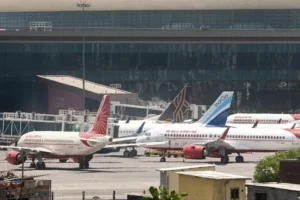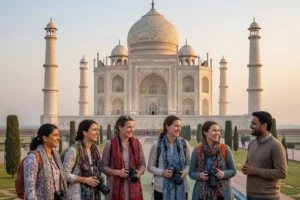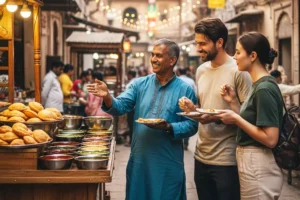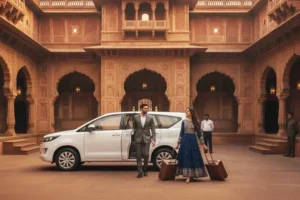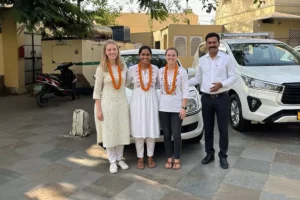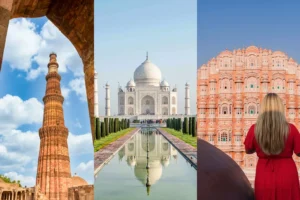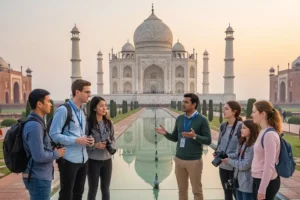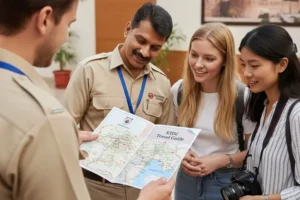When to Visit Delhi, Agra, Jaipur, and the Taj Mahal
So here’s something I wish someone told me before I booked my first trip through India’s Golden Triangle — timing seriously matters. Like, more than you think. Delhi, Agra, and Jaipur are all unforgettable in their own ways, but trust me, the weather and season you go in can totally change your experience. I still remember wandering through Old Delhi sweating buckets in June (rookie mistake), and then a year later doing the same walk in January — totally different vibe. The cool air made everything feel calmer, more alive somehow. Agra’s Taj Mahal? Seeing it at sunrise in the winter with a little morning mist... it’s hard to put into words. And Jaipur’s pink streets are way more enjoyable when you’re not constantly hunting for shade. Anyway, this isn’t just some travel tip post — it’s more like a heads-up from someone who’s been there, messed it up once, and got it right the next time. In this little guide, I’ll walk you through what to expect season-wise, how to prepare, and why choosing the right month can honestly make or break your Golden Triangle adventure.

Why Timing Matters for the Golden Triangle Trip
The Golden Triangle Trip—covering Delhi, Agra, and Jaipur—is one of the most popular travel circuits in India. However, choosing the right time to visit can make a big difference in your experience. The weather, crowd levels, and local events all play a crucial role in how enjoyable your journey becomes.
Planning your Golden Triangle Tour between October and March is highly recommended. During these months, the weather across North India is pleasant, with cool breezes and clear skies—ideal for sightseeing and outdoor exploration. From exploring the Taj Mahal in Agra to discovering the forts and palaces of Jaipur and the historical monuments of Delhi, winter offers the most comfortable travel conditions.
On the other hand, the summer season (April to June) brings extremely high temperatures, especially in Rajasthan, making daytime sightseeing challenging. Meanwhile, the monsoon season (July to September) brings lush greenery and fewer crowds, offering a more peaceful and budget-friendly travel experience for those who don’t mind occasional rain.
Timing also affects your ability to enjoy cultural festivals and events. Traveling during Diwali, Holi, or Jaipur Literature Festival can add a vibrant and authentic cultural dimension to your Golden Triangle experience. However, it’s wise to book accommodation and transport in advance during these peak times.
In short, selecting the best time for the Golden Triangle Trip ensures you experience India’s rich heritage, colorful culture, and stunning landmarks in the most comfortable and rewarding way possible.
Understanding the Climate in North India
Before diving into the specifics of each destination, it’s important to understand the climate in North India. The region experiences three main seasons: summer, monsoon, and winter. Each season has its characteristics, and knowing these will help you choose the best time to visit.
- Summer (April to June):
- Temperature: Summers in North India are extremely hot, with temperatures often exceeding 40°C (104°F). Delhi, Agra, and Jaipur can become quite uncomfortable during this time, especially for those not used to such intense heat.
- Travel Experience: The heat can make daytime sightseeing challenging. However, this is the off-season for tourism, so you might find lower prices on accommodations and fewer crowds at major attractions. If you do travel during this time, plan your outdoor activities early in the morning or late in the evening when temperatures are slightly cooler.
- Monsoon (July to September):
- Temperature: The monsoon season brings much-needed relief from the summer heat, with temperatures ranging from 25°C to 35°C (77°F to 95°F). However, this period also sees heavy rainfall, which can sometimes disrupt travel plans.
- Travel Experience: The rain can make the landscape lush and green, offering a different perspective of the cities. However, the rains can also lead to delays in travel and affect outdoor activities. It's a less popular time for tourists, so you may enjoy quieter experiences at popular sites.
- Winter (October to March):
- Temperature: Winter is the most pleasant season in North India, with temperatures ranging from 8°C to 20°C (46°F to 68°F). This is the peak tourist season, as the cooler weather is perfect for sightseeing.
- Travel Experience: With clear skies and mild temperatures, winter is the best time for outdoor activities and exploring the cities. This season also coincides with many festivals and events, adding to the cultural richness of your experience. However, because it is the most popular time to visit, you’ll find more tourists and higher prices on accommodations.
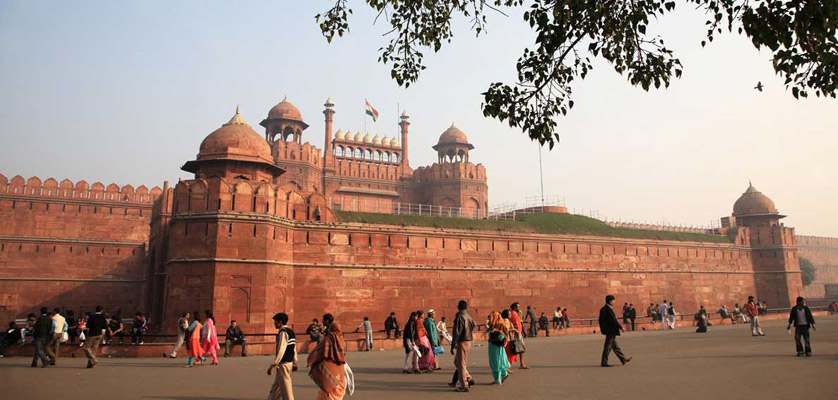
Best Time to Visit Delhi: A City of Contrasts
Delhi, the capital of India, is a city that seamlessly blends the old with the new. From ancient monuments and bustling markets to modern skyscrapers and shopping malls, Delhi offers something for everyone.
- Optimal Season: October to March is the ideal time to visit Delhi. The winter months provide cool and comfortable weather, making it easy to explore the city's numerous attractions. Whether you're wandering through the narrow lanes of Old Delhi or enjoying the greenery of the city’s many parks, the pleasant weather will enhance your experience.
- Key Events:
- Diwali (October/November): Diwali, the Festival of Lights, is one of the biggest festivals in Delhi. The city is lit up with millions of lights, and the festive atmosphere is infectious. It's a great time to experience the city's culture and traditions.
- Republic Day (January 26): Republic Day is celebrated with a grand parade at India Gate, showcasing India’s military strength and cultural diversity. The parade is a major event in Delhi, drawing visitors from all over the country.
- Delhi International Arts Festival (January/February): This festival is a celebration of art and culture, featuring performances by artists from around the world. It's a great opportunity to experience a wide range of music, dance, theater, and visual arts.
- What to See and Do:
- Historical Sites: Delhi is home to several UNESCO World Heritage Sites, including the Red Fort, Qutub Minar, and Humayun’s Tomb. These historical monuments offer a glimpse into the city’s rich past.
- India Gate: A monumental war memorial in Delhi, India Gate honors soldiers who died in World War I. Its grand arch and intricate carvings make it a landmark.
- Red Fort Delhi: an iconic symbol of India's Mughal heritage, features striking red sandstone walls, massive gates, and stunning architecture, reflecting the grandeur of the Mughal era.
- Humayun’s Tomb: a UNESCO World Heritage Site, is a stunning Mughal mausoleum in Delhi, featuring exquisite gardens, intricate marble inlay work, and a harmonious architectural design.
- Jama Masjid: one of India’s largest mosques, boasts impressive red sandstone and marble architecture, vast courtyards, and towering minarets, reflecting Mughal architectural brilliance.
- Akshardham Temple in Delhi: is a grand Hindu temple complex, renowned for its elaborate carvings, expansive gardens, and intricate sculptures, showcasing traditional Indian art and spirituality.
- Religious Sites: Delhi is also known for its diverse religious heritage. Visit the Lotus Temple, a Bahá'í House of Worship known for its unique architecture, or the Akshardham Temple, a stunning example of Indian art and architecture.
- Markets and Shopping: Delhi’s markets are a shopper’s paradise. Explore the bustling lanes of Chandni Chowk for traditional Indian goods, or visit Connaught Place for more contemporary shopping.
- Parks and Gardens: If you’re looking for some peace and quiet, Delhi has plenty of green spaces. Lodhi Gardens and the Garden of Five Senses are perfect for a relaxing stroll.
- Cultural Experiences:
- Food: Delhi is famous for its street food, and no visit is complete without trying some of the local delicacies. From spicy chaat and crispy samosas to rich butter chicken, the city’s food scene is vibrant and diverse.
- Theater and Performances: Delhi has a thriving performing arts scene. Catch a play at the National School of Drama or enjoy a classical music performance at the India Habitat Centre.

Best Time to Visit Agra: The City of the Taj Mahal
Agra, located on the banks of the Yamuna River, is best known for the Taj Mahal, one of the Seven Wonders of the World. But there’s more to Agra than just the Taj. The city is rich in Mughal history, with stunning architecture and fascinating stories at every turn.
- Optimal Season: November to February is the best time to visit Agra. The cool weather during these months makes it perfect for exploring the Taj Mahal, Agra Fort, and other attractions. The early morning or late afternoon is the ideal time to visit the Taj Mahal to avoid the crowds and see the monument in the best light.
- Key Events:
- Taj Mahotsav (February): This 10-day cultural festival celebrates the rich heritage of Agra. It features traditional dance, music, art, and cuisine, offering a great way to experience the local culture.
- Ram Barat (September/October): This grand procession marks the wedding of Lord Ram and is celebrated with great pomp and show in Agra. The streets come alive with vibrant decorations, music, and performances.
- What to See and Do:
- Taj Mahal: The Taj Mahal is the main attraction in Agra and for a good reason. This white marble mausoleum is an architectural masterpiece and a symbol of eternal love. Visit at sunrise or sunset for the most magical experience.
- Agra Fort: Just a few kilometers from the Taj Mahal, Agra Fort is another UNESCO World Heritage Site. This red sandstone fort offers stunning views of the Taj Mahal and is a fascinating place to explore.
- Fatehpur Sikri: A short drive from Agra, Fatehpur Sikri is an ancient city built by Emperor Akbar. The city is now in ruins, but it still holds an aura of grandeur and mystery.
Planning a visit? Taj Mahal ticket price and timings here.
- Cultural Experiences:
- Shopping: Agra is famous for its handicrafts, especially marble inlay work. You’ll find beautiful souvenirs like miniature Taj Mahals, jewelry boxes, and coasters. The markets of Sadar Bazaar and Kinari Bazaar are great places to shop.
- Food: Agra’s culinary scene is heavily influenced by Mughal cuisine. Don’t miss trying the famous Agra petha, a sweet made from ash gourd. Also, indulge in dishes like Mughlai curries, kebabs, and biryanis.
- Photography Tips:
- The Taj Mahal looks stunning in the soft light of dawn or dusk. If you’re an early riser, try to capture the first light hitting the marble dome. The Yamuna River, which flows behind the Taj Mahal, also offers a unique perspective for photography.

Best Time to Visit Jaipur: The Royal Pink City
Jaipur, the capital of Rajasthan, is known as the Pink City due to the distinctive color of its buildings. It’s a city of royal heritage, with majestic forts, palaces, and vibrant markets that offer a glimpse into the opulent lifestyle of the Rajput rulers.
- Optimal Season: November to March is the best time to visit Jaipur. The weather is cool and comfortable, making it perfect for exploring the city’s many attractions, including Amber Fort, Hawa Mahal, and City Palace. The cooler evenings are ideal for enjoying a traditional Rajasthani meal or attending cultural performances.
- Key Events:
- Jaipur Literature Festival (January): The world’s largest free literary festival, the Jaipur Literature Festival, attracts writers, thinkers, and book lovers from around the globe. It’s a great opportunity to engage with authors, attend talks, and participate in discussions on a wide range of topics.
- Elephant Festival (March): Celebrated on the eve of Holi, the Elephant Festival is a unique event where elephants are decorated in vibrant colors and paraded through the city. The festival also includes cultural performances, games, and an overall festive atmosphere.
- Diwali (October/November): Diwali in Jaipur is a spectacular affair. The entire city is illuminated with lights, and the markets are bustling with activity. It’s a great time to experience the local culture and traditions.
- What to See and Do:
- Amber Fort: Located on a hilltop overlooking the Maota Lake, Amber Fort is one of the most popular attractions in Jaipur. The fort’s intricate architecture, mirror work, and stunning views make it a must-visit. You can also enjoy an elephant ride to the top of the fort.
- Hawa Mahal: Known as the Palace of Winds, Hawa Mahal is an iconic symbol of Jaipur. The five-story palace has 953 small windows, allowing the royal ladies to observe street life without being seen. It’s a great spot for photography, especially in the early morning.
- City Palace: The City Palace is a sprawling complex that includes courtyards, gardens, and buildings. It’s still home to the royal family of Jaipur and offers a glimpse into their regal lifestyle. Don’t miss the museum, which houses a collection of royal costumes, weapons, and artifacts.
- Jantar Mantar: A UNESCO World Heritage Site, Jantar Mantar is an astronomical observatory built in the 18th century. It features a collection of nineteen architectural astronomical instruments, including the world’s largest stone sundial.
- Monkey Temple: an ancient Hindu pilgrimage near Jaipur, Rajasthan, features temples built in a crevice among hills. A natural spring flows into sacred kunds, where pilgrims bathe. The site offers panoramic views of Jaipur from a hilltop temple and honors the saint Galav, who meditated here
- Royal Gaitor Tumbas: serve as the final resting place for the Maharajas of Rajasthan. Situated in Brahmpuri, just 1 km from Jaipur, this historical site lies at the base of the Nahargarh Fort. The majestic cenotaphs, constructed at the cremation grounds, are a striking fusion of Islamic and Hindu architectural styles. Each intricately carved cenotaph mirrors the unique aesthetic preferences of the individual Maharajas they honor
- Jal Mahal: set in the center of Man Sagar Lake, is a picturesque palace often referred to as the "Water Palace" for its serene reflection in the lake
- Panna Meena Stepwell : in Jaipur is a stunning, ancient water reservoir with intricate geometric patterns and a serene, historical ambiance.
- Cultural Experiences:
- Shopping: Jaipur is a paradise for shoppers. The city is famous for its jewelry, textiles, and handicrafts. Johari Bazaar is the place to go for gemstones and jewelry, while Bapu Bazaar offers a wide range of textiles, including the famous Rajasthani bandhani (tie-dye) fabrics.
- Food: Rajasthani cuisine is known for its rich flavors and variety. Don’t miss trying dal baati churma, a traditional dish made of lentils, wheat balls, and a sweetened mixture. Other must-try dishes include laal maas (spicy mutton curry) and ghewar (a sweet dish made from flour and sugar syrup).
- Cultural Performances: Jaipur is a city that loves its culture. Attend a traditional dance or music performance at one of the city’s many cultural centers, such as the Jawahar Kala Kendra or the Amber Fort Sound and Light Show.
- Photography Tips:
- Jaipur’s vibrant colors and architectural beauty make it a photographer’s paradise. Capture the sunrise over Amber Fort or the intricate details of Hawa Mahal. The city’s markets also offer great opportunities for street photography.

Practical Tips for Traveling to Delhi, Agra, and Jaipur
Now that you know the best times to visit and what to do in Delhi, Agra, and Jaipur, here are some practical tips to help you make the most of your trip.
- Plan Ahead: The best time to visit these cities coincides with peak tourist season, so it’s important to plan ahead. Book your flights, hotels, and tours well in advance to avoid last-minute hassles and ensure availability.
- Pack Accordingly: Depending on the time of year you visit, packing the right clothes is essential. In winter, bring layers as temperatures can drop significantly at night. In summer, lightweight and breathable clothing is a must. Also, don’t forget to pack comfortable shoes for all the walking you’ll be doing.
- Stay Hydrated: The dry climate in North India can lead to dehydration, especially if you’re visiting during the summer months. Carry a water bottle with you at all times and drink plenty of fluids.
- Respect Local Customs: India is a country with deep-rooted traditions and customs. Dress modestly, especially when visiting religious sites. It’s also important to be mindful of local etiquette, such as removing your shoes before entering a temple or someone’s home.
- Be Prepared for Crowds: Delhi, Agra, and Jaipur are popular tourist destinations, so be prepared for crowds, especially at major attractions like the Taj Mahal and Amber Fort. Visiting early in the morning or late in the afternoon can help you avoid the peak crowds.
- Transportation: Getting around these cities can be a challenge, especially with the traffic in Delhi and Jaipur. Consider hiring a private car and driver for convenience, or use ride-sharing apps like Uber and Ola. In Agra, auto-rickshaws are a popular mode of transport.
- Local Cuisine: Trying the local cuisine is a must-do on any trip to India. However, if you’re not used to spicy food, start with milder dishes and gradually work your way up. Always drink bottled water and avoid street food if you have a sensitive stomach.
- Photography Etiquette: While photography is generally allowed at most tourist sites, always ask for permission before taking photos of people, especially in rural areas or at religious sites.
Conclusion: Making the Most of Your Golden Triangle Adventure
Visiting Delhi, Agra, and Jaipur is like stepping into a different world, where history, culture, and modern life blend seamlessly. Each city has its unique charm and offers something different, from the bustling markets of Delhi to the serene beauty of the Taj Mahal and the royal grandeur of Jaipur.
The best time to visit these cities is during the winter months of October to March when the weather is cool and pleasant. This is the ideal time to explore the cities' many attractions, participate in local festivals, and immerse yourself in the rich cultural experiences that the Golden Triangle has to offer.
With careful planning and a bit of preparation, your trip to Delhi, Agra, and Jaipur will be an unforgettable journey filled with memories that will last a lifetime. Whether you’re a history buff, a foodie, or a photography enthusiast, these cities offer endless opportunities to explore, discover, and enjoy.
So pack your bags, plan your itinerary, and get ready to embark on a journey through one of the most fascinating regions of India. Your adventure awaits!
About the Author
Written by Sameer Khan, a Rajasthan-based travel expert with over 10 years of experience organizing Golden Triangle Tours, Jaipur Sightseeing Trips, and Private Rajasthan Tours for international travelers.
Sameer has helped hundreds of visitors explore India’s vibrant culture, rich heritage, and royal architecture with customized travel experiences and professional driver services. His expert insights make his travel blogs a trusted source for anyone planning a trip to North India.
Last Updated: October 2025-26
📞 Contact / WhatsApp: +91 95719 15083

